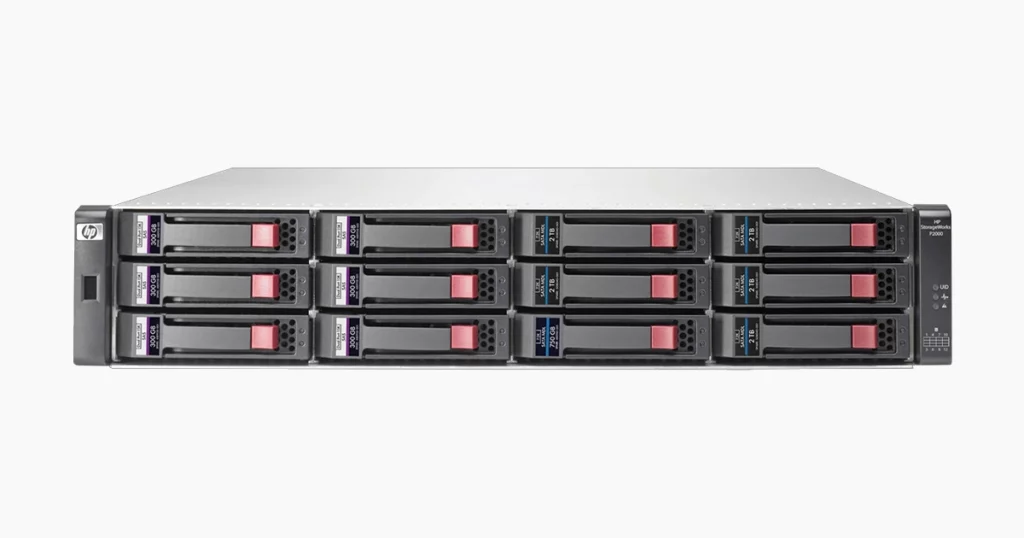The Critical HPE P2000 Failure
A Florida-based company recently faced a serious HPE StorageWorks P2000 failure that disrupted access to its enterprise data. The P2000 SAN device played a vital role in centralizing large volumes of business-critical information. When multiple drives suddenly became unreadable, the company’s operations were immediately affected.
The situation became more complicated when they discovered that HPE no longer provides official support for this model.
Without vendor assistance, recovery options were limited and risky. The IT team tried replacing a failed drive, but two additional drives soon entered a degraded state, preventing the array from rebuilding.
This left the organization with an urgent decision, either wait indefinitely for unsupported components or seek professional help to avoid permanent data loss. The case highlights how essential a reliable SAN infrastructure is for maintaining business continuity.
To understand how SAN systems differ from NAS setups, you can review our SAN vs NAS article.

About the HPE StorageWorks P2000 System
The HPE StorageWorks P2000 is a modular SAN array used in small and mid-sized enterprises. It operates on SAS or Fibre Channel interfaces and supports several RAID configurations such as RAID 5 and RAID 6 for balanced performance and redundancy.
In this case, the system stored essential customer data and internal records, making uptime a key requirement. Because the P2000 is an end-of-life product, sourcing replacement parts or firmware updates has become increasingly difficult, which complicates recovery when hardware issues arise.
For more insights into enterprise storage types, explore our SAN vs DAS comparison.
Failure Incident and Early Symptoms
The company’s HPE P2000 RAID system showed several warning signs before complete failure. The sequence of events unfolded as follows:
Initial drive failure: One SAS drive stopped responding, triggering a warning in the management console.
Drive replacement: The IT team replaced the failed drive, expecting the array to rebuild successfully.
Additional degradation: Two more drives soon entered a degraded state, halting the rebuild process.
Array inaccessibility: The system became unstable, and all connected users lost access to stored data.
Error diagnostics: Multiple parity and synchronization errors appeared during RAID verification, confirming severe logical corruption.
These progressive symptoms indicated that the issue extended beyond a single drive failure and required a professional RAID data recovery approach.

Challenges in Recovery
Recovering data from the HPE StorageWorks P2000 presented several technical difficulties. Since the device was no longer supported by HPE, obtaining compatible replacement drives and firmware was nearly impossible.
Our engineers identified the following key challenges during evaluation:
End-of-life hardware: Replacement parts and controller updates were unavailable through official channels.
Multiple degraded drives: With more than one failed drive, the array could not safely rebuild.
Inconsistent metadata: Corrupted parity and damaged metadata made logical reconstruction complex.
Unsupported firmware versions: Compatibility issues prevented direct access to the RAID configuration.
These conditions significantly increased the risk of permanent data loss if improper rebuild attempts were made. You can read more about similar situations in our guides on troubleshooting RAID failure and reasons for RAID data loss.
Our Data Recovery Process
After receiving the failed HPE P2000 SAN, our engineers began a complete diagnostic assessment in a controlled lab environment. Each drive was carefully examined to identify physical and logical faults before any recovery steps were taken.
Every disk was cloned using sector-by-sector imaging to preserve original data.
The RAID configuration, including disk order, block size, and parity rotation, was manually rebuilt.
Using the reconstructed parameters, our team created a virtual RAID to safely access the data.
Extracted data was validated through hash comparison to ensure file integrity.
In complex cases, controller incompatibility can complicate recovery. For more insight into how these failures are addressed, see our RAID controller failure recovery article.

Outcome: Successful Data Restoration
Following a detailed reconstruction and data verification process, our engineers successfully restored the complete dataset from the failed HPE StorageWorks P2000 array. The recovery included customer records, accounting databases, and internal documentation essential for daily operations.
After the recovery, all files were transferred to a secure external storage device and validated by the client. System functionality was restored within 72 hours of receiving the array, allowing the company to resume operations without any data loss.
The case demonstrates that even when dealing with unsupported or legacy hardware, a precise and methodical recovery approach can achieve full data restoration and minimize downtime for enterprise environments.
Fast turnaround times for business-critical data
Key Lessons and Preventive Measures
This recovery highlights several important lessons for businesses relying on aging or unsupported storage systems:
Avoid legacy storage hardware. End-of-life devices lack firmware updates and compatible components, increasing failure risks.
Implement proactive RAID monitoring. Early detection of degraded drives can prevent complete data loss.
Maintain reliable backup routines. Regular backups and off-site replication ensure data safety during hardware issues.
Plan timely system upgrades. Replace outdated SAN units before manufacturer support ends.
To learn more about safeguarding enterprise environments, visit our data loss prevention article. You can also review a similar enterprise case involving HPE Nimble Storage recovery.
Conclusion
The HPE StorageWorks P2000 recovery case demonstrates how professional intervention can restore critical data even when multiple drives fail and vendor support is unavailable. With careful diagnostics, secure imaging, and precise RAID reconstruction, it is possible to recover business data from complex enterprise systems.
If your SAN or RAID array becomes inaccessible or shows signs of degradation, do not attempt a rebuild without professional assessment.
Contact RAID Recovery Services to schedule an evaluation and protect your data from further risk.
Our specialists are available 24/7 to help you recover and secure your enterprise storage.

Trust the experts with proven results
Frequently Asked Questions
What should I do when my HPE StorageWorks P2000 stops responding?
Immediately power down the device and avoid rebuilding the array. Continued operation can overwrite recoverable data. Contact a professional recovery team to evaluate the drives safely.
Can data be recovered from an HPE P2000 with multiple degraded drives?
Yes. In most cases, recovery is possible by imaging each drive and reconstructing the RAID configuration virtually. The success rate depends on drive condition and prior rebuild attempts.
Why is recovery difficult on unsupported HPE models?
End-of-life systems like the P2000 lack firmware updates and replacement parts, which complicates rebuilds and controller compatibility during recovery.
How long does enterprise SAN recovery take?
It varies based on capacity and failure type. Most professional recoveries are completed within 48 to 72 hours after diagnostics.
Can RAID Recovery Services handle other HPE storage systems?
Yes. Our engineers specialize in HPE SAN, NAS, and server recovery, including Nimble and ProLiant environments.